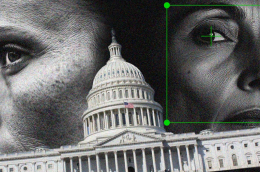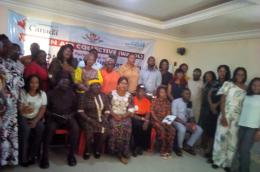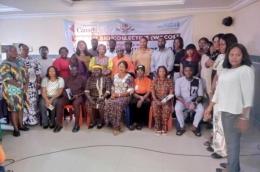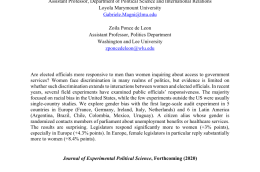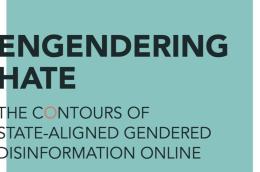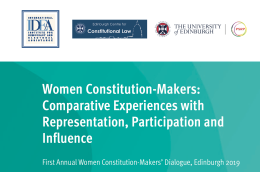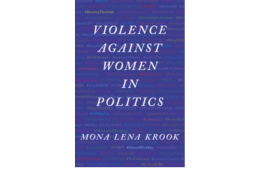Women's Leadership
Main navigation
A new report has found that women in Congress are 70 times more likely to be targeted by deepfakes than men, often with sexually explicit images created by AI.
The American Sunlight Project (ASP) found that out of over 35,000 images of politicians, 26 different people have been exposed to non-consensual intimate imagery (NCII).
Out of these, 25 were women. Strikingly, one in six congress women have fallen victim to non-consensual imagery.
This is particularly concerning as Congress has previously introduced bills such as the Defiance Act, which criminalizes such activity. However, according to news outlet the 19th, due to the bureaucracy of the American political system, the House is still awaiting approval to finalize the legislation.
In a separate study by the Center for Countering Digital Hate, an analysis of the comments on Instagram posts for women currently in power found that one in ten comments was highly likely to be toxic, with a staggering 93% of reports ignored by Instagram, as previously reported.
Read here the full article published by Cyber News on 16 December 2024.
Image by Cyber News
A new report published by the Open Nepal Initiative (ONI) sheds light on the increasing number of incidents of online violence targeting women politicians in Nepal.
The study says the pervasive issue undermines democratic participation and silences critical voices in public discourse. “The findings, based on monitoring the social media accounts of 12 prominent women politicians over three months (August–October 2024), expose alarming patterns and highlight the urgent need for action to create safer digital spaces,” a press release issued by the organisation on Sunday said.
The study finds that X, formerly Twitter, emerged as the primary platform for online abuse, accounting for most incidents during all three months. The anonymity and reach of social media have enabled perpetrators to launch coordinated attacks, spreading disinformation and gendered hate speech against female politicians, it said.
The study found that lawmakers Toshima Karki of Rastriya Swatantra Party, Sumana Shrestha of the same party and Minister for Foreign Affairs Arzu Rana Deuba of Nepali Congress are among the most targeted politicians.
Read here the full article published by The Kathmandu Post on 16 December 2024.
Image by The Kathmandu Post
The Coordinator, Afikpo North East Development Center, Comrade Ibe Immaculata Nnenna has urged women to encourage/support fellow women in office rather than castigate or seek their downfall.
The female politician spoke at a one-day high level multi-stakeholder’s roundtable on improving women’s political participation in Nigeria.
The event was organised by a Civil Society Organisation, Women Aid Collective, in partnership with UN Women, with support from the Government of Canada.
Sharing her experience as a young woman politician in Ebonyi State, Ibe, said the major hindrance she encountered in her political career were imposed by her fellow women.
She noted that as a young woman in politics, only few elderly ones showed willingness to extend mentorship to her while others were always bent on frustrating her efforts using diverse strategies.
Read here the full article published by 247ureports on 27 November 2024.
Image by 247ureport
The politician spoke at a one-day high level multi-stakeholder’s roundtable on enhancing women’s political participation in Nigeria.
The event was organised by a Civil Society Organisation, Women Aid Collective, in partnership with UN Women, with support from the Government of Canada.
Sharing her experience as a young woman politician in Ebonyi State, Ibe, the Development Centre Coordinator of Afikpo Northeast in Afikpo Local Government Area of Ebonyi State, said the major roadblocks she encountered in her political career were imposed by her fellow women.
Others, she said, were always bent on frustrating her efforts using diverse strategies.
She stressed that men are not the major problem of women in making their marks in Nigerian politics, maintaining that women out of mutual jealousy scandalise their fellow women, fabricating all kinds of lies to discredit their fellow women excelling in politics or seeking political positions.
Ibe narrated: “Before I became an office holder, I was thinking that men are our problem.
“At every occasion I would always be saying that the men should be told to give us a chance; tell the men to give us 35 percent affirmative action.
“But now I have discovered that the problem is not totally from men.
Read here the full article published by The Eagle Online on 22 November 2024.
Image by The Eagle Online
Beyond the ballot box
The election results reflect broader societal patterns affecting advancement in politics and other spheres. Despite increasing representation in various fields, the path to executive positions remains complex. This reality resonates particularly with established professionals who have navigated similar dynamics throughout their careers.
The conversation extends beyond individual candidates to examine institutional structures that influence leadership selection. As more voices join public discourse, many note how traditional power dynamics continue to shape outcomes across sectors.
Creating sustainable change
Community engagement and strategic coalition-building emerge as critical factors for progress. Grassroots organizations are developing new approaches to leadership development and support systems. These efforts focus on long-term institutional change rather than individual electoral cycles.
An April 2023 Pew Research Center report shows increasing political participation among diverse demographics, suggesting potential for future breakthrough moments. Thus, sustainable progress requires addressing deeper systemic issues around access and opportunity.
Read here the full article published by Rolling Out on 20 November 2024.
Image by Rolling Out
South Sudan UN Women Country Representative Rukaiya Mohammed has underscored the importance of dialogue in empowering women.
Mohammed expressed the sentiments during the three-day inter-generational dialogue on women’s leadership and political participation from East Africa.
The workshop held in Juba created a platform on breaking barriers for women in leadership.
“The transition period has been extended for two years, so we say women should not sleep. We should strategize and take advantage of the momentum,” Mohammed said.
“We said the young can walk fast, but the elderly know the road. It is vital for young women to harness the wisdom of the elders, while the elders should value the creativity and energy of the youth,” she added.
The dialogue included members of the East African Legislative Assembly (EALA) from Kenya, Rwanda, and South Sudan, local MPs, and representatives from civil society organizations (CSOs).
Read here the full article published by Radio Tamazuj on 16 November 2024.
Image by Radio Tamazuj
